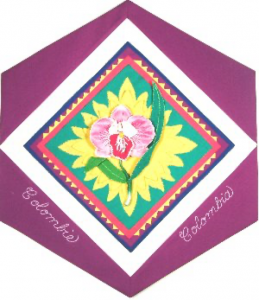Colombia

The Block
Appliquéd work is often used to illustrate scenes or elements of everyday life in Colombia. The block, designed by Aida Ramirez Mesa and stitched by Jeannette Schaak features the country’s national flower, the Cattleya orchid. It is reproduced, in varying shades of pink and violet silk, using both the three-dimensional and flat versions of this technique. Colombia produces and exports a variety of flowers, including thousands of species of orchids. Yellow petals surrounding the orchid are symbolic of the plentiful sunshine found in Colombia. The background of this piece is made using the mola technique. This unique, reverse-appliqué style of needlework, traditionally done by Kuna Indians, involves several layers of differently coloured cotton. Fabric is cut away and the edges turned under and stitched to expose the lower layer of material. This piece includes a saw-tooth edged layer of yellow, as well as a layer of green (for the mountains), pink and violet (for the abundance of flowers), and blue (for the ocean).
Cultural Profile
Colombia, the only South American nation with coastlines on both the Pacific Ocean and the Caribbean Sea, is a country of beautiful colonial architecture, carved stone figures and the finest emeralds in the world. It is also one of the world’s largest coffee producers. Spanish is the official language, although some 850,000 people can speak one of the many indigenous languages. Some words that have entered the English language, such as canoe, tobacco and hammock, come from one of these indigenous groups, the Arawak.
One of the most commonly used words in Colombia is mañana (tomorrow). More clearly understood as ‘in the indefinite future,’ it reflects a Colombian’s relaxed sense of time and punctuality. Colombians love music and have a rich tradition of folk music and dance that reveals African and Native American influences. The bambuco is both the national dance and a form of song that uses guitars extensively, including the Colombian tiple, a 12-string guitar. Numerous festivals, carnivals and fairs are celebrated throughout the year. The carnivals especially, which had their origins in the practices of the Roman Catholic Church, show how indigenous and African cultural elements have been integrated into Colombian celebrations over the past centuries. The carnival in Pasto is said to date back to the 17th century, and was given as a day of rest to the local slaves by the Spanish king, making it one of the oldest carnivals in the Americas.
Colombians are also recognized for their decorative arts such as decorated ceramics, basketry, leatherwork and woven blankets. The Arhuaca knapsack, or mochila, a bag woven of cotton or agave fibers in beige, brown and gray and woven by the indigenous Arhuaco women, is a sought-after item as a cultural symbol of Colombia. Another national symbol is the sombrero vueltiao made by the Zenù people, a hat made of cane fibers and dyed using mud. Some of the most refined vueltiaos can take up to one month to make, and are so resilient that they can be folded and put in a pocket without losing their shape. The Wayùu women are noted for their weaving and crochet work. Weaving abilities used to increase the dowry of a girl, a sign of the importance given to these skills in this matriarchal culture. The Wayùus make mochilas using their own bright colours and geometric patterns. Another craft specific to Colombia is Pasto glazing. In this technique, the artisan applies the resin of the mopa-mopa tree to wood items to create brightly coloured designs.
In Colombian society, etiquette and propriety are valued. Parents work hard to instil in their children the idea of respecting their elders. The system of compadrazgo (copaternity) is also important. Relationships are established beyond the family through the selection of compadres (godparents) who act as a second set of parents.
Colombians have been coming to Canada since 1974, settling in Ontario, British Colombia and Alberta. As of 2011, 74,000 Colombians live in Canada. Various cultural organizations have been established such as the Comunidad de Ottawa-Gatineau, Comunidad de Columbia Británica and the Comunidad de Calgary and Colombians actively participate in the many events sponsored by these associations.
Sponsor: Aida Ramirez-Mesa
